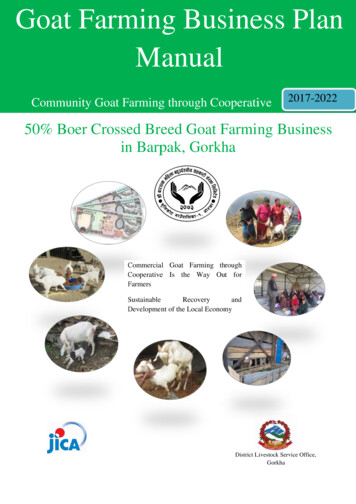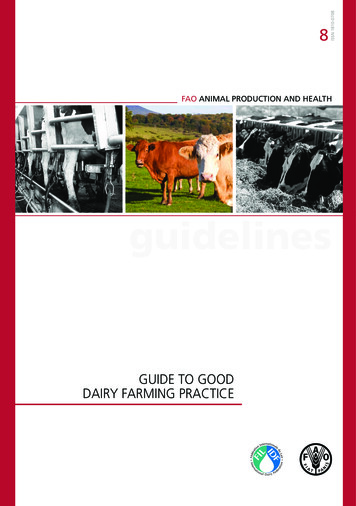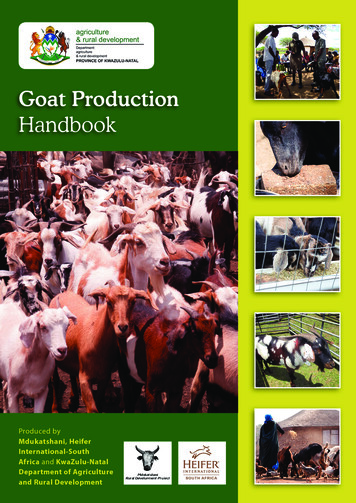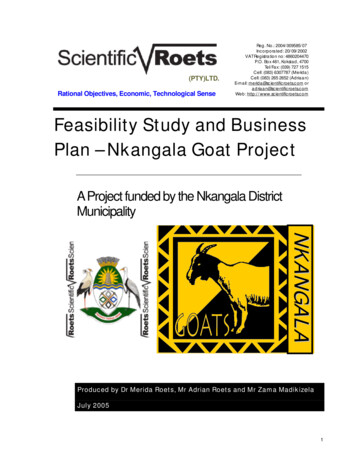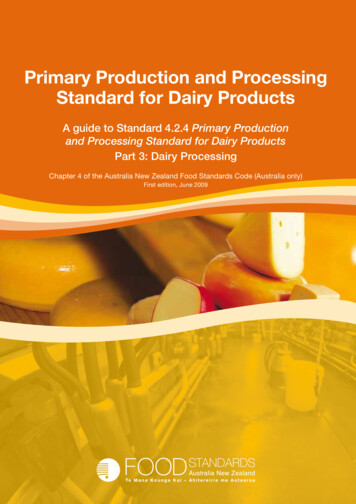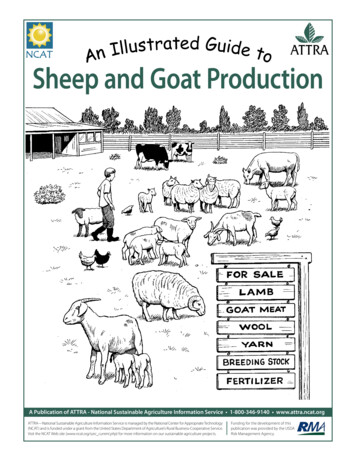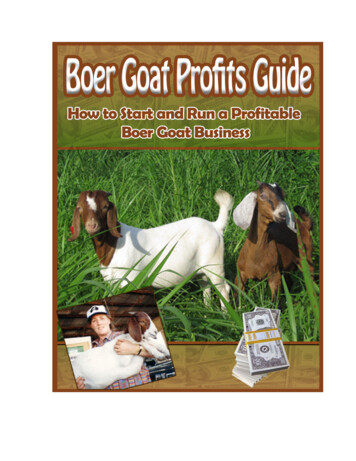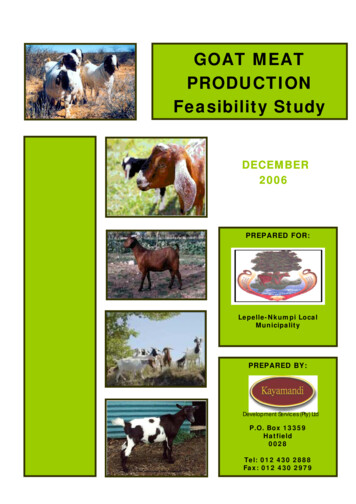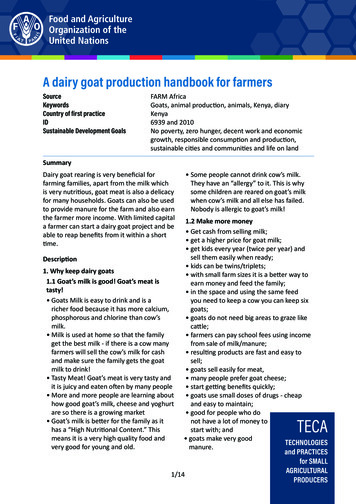
Transcription
A dairy goat production handbook for farmersSource FARM AfricaKeywords Goats, animal production, animals, Kenya, diaryCountry of first practiceKenyaID 6939 and 2010Sustainable Development GoalsNo poverty, zero hunger, decent work and economicgrowth, responsible consumption and production,sustainable cities and communities and life on landSummaryDairy goat rearing is very beneficial forfarming families, apart from the milk whichis very nutritious, goat meat is also a delicacyfor many households. Goats can also be usedto provide manure for the farm and also earnthe farmer more income. With limited capitala farmer can start a dairy goat project and beable to reap benefits from it within a shorttime.Description1. Why keep dairy goats1.1 Goat’s milk is good! Goat’s meat istasty! Goats Milk is easy to drink and is aricher food because it has more calcium,phosphorous and chlorine than cow’smilk. Milk is used at home so that the familyget the best milk - if there is a cow manyfarmers will sell the cow’s milk for cashand make sure the family gets the goatmilk to drink! Tasty Meat! Goat’s meat is very tasty andit is juicy and eaten often by many people More and more people are learning abouthow good goat’s milk, cheese and yoghurtare so there is a growing market Goat’s milk is better for the family as ithas a “High Nutritional Content.” Thismeans it is a very high quality food andvery good for young and old. Some people cannot drink cow’s milk.They have an “allergy” to it. This is whysome children are reared on goat’s milkwhen cow’s milk and all else has failed.Nobody is allergic to goat’s milk!1.2 Make more money Get cash from selling milk; get a higher price for goat milk; get kids every year (twice per year) andsell them easily when ready; kids can be twins/triplets; with small farm sizes it is a better way toearn money and feed the family; in the space and using the same feedyou need to keep a cow you can keep sixgoats; goats do not need big areas to graze likecattle; farmers can pay school fees using incomefrom sale of milk/manure; resulting products are fast and easy tosell; goats sell easily for meat, many people prefer goat cheese; start getting benefits quickly; goats use small doses of drugs - cheapand easy to maintain; good for people who donot have a lot of money tostart with; and goats make very goodTECHNOLOGIESmanure.1/14TECAand PRACTICESfor SMALLAGRICULTURALPRODUCERS
Livestock ProductionFigure 1. Comparison of goat milk, cow milk and human milkcontentSource: FARM Africa 2010Figure 2. Goat waste as manure FAO/TECA1.3. Goats are good for the farm Less feed is needed to keep a goat than acow; goats will eat many different plants - sothey are easier to keep fed through theyear; droppings are used as manure for organicfarming; goats are good at keeping bush undercontrol - they stop too much shrubgrowth; goats will live even where there is adrought as they do not need a lot of waterand can go for quite a long time withoutwater in very dry times.1.4 Goat rearing do not require so muchwork Goats require less labour and time perhead compared to cattle.2/141.5 Important for Social events Goats are used traditionally as payment ofdowry; goats are often eaten during land cases,parties, clan meetings, etc.; goats are important in some rituals, theyare used during circumcision ceremoniesfor example; and
goat horn and bone are used in thetraditional craft industry.budget so construction of a simple housebut comfortable house for the goats isrecommended. The house can be builtusing local materialFigure 3. Goats are used in social eventsFigure 4. Proper housing for the goat: Inside FAO/TECA2.2. Types of HousesAt the beginning of the project it’sassumed the farmer is working on a limited3/14Figure 5. Proper housing for the goat: Outside FAO/TECAIf you build a goat house like the one shownthen you will: make sure Animals do not get sick veryoften; you can make sure that only the animalsyou want to breed do so; make it very easy to feed; stop wasting feed; save the goats wasting energy andincrease the amount of milk you get; and keep goat’s feet dry and clean all the time. FAO/TECA2. Housing the goat2.1 Good goat house will make keepinggoats easierA good goat house should be: rain proof; damp proof; well ventilated; free from direct wind; free from sharp objects that might cut thegoat; pest and wild animal proof; slats on floor for free fall of droppings;and with an area of at least 2 meters peranimal.2.2.1 Mud housesThis is the cheapest house to buildbecause it uses local materials: posts; mud; rafters for floor; nails; and grass for thatch roof.When placing mud, make holes in the wallslanting down so that, the air does notland directly on the goats.
feed trough/water area; place for hanging fodder [feed racks]; floor with slats to let manure fall throughthat keeps feet and animals clean anddry; and place to hang mineral block (placedwhere it cannot be rained on).Figure 6. Mud housing2.2.2 Off-cuts housesThis house costs a little more but it will lastlonger. Materials: posts; off-cut planks; nails; iron sheets or grass for thatching; and wood - rafters or planks for the floor. FAO/TECA FAO/TECAFigure 7. Sleeping area of the house FAO/TECAFigure 8. Off-cut housing2.3. The houseThere are two main areas of the house, thesleeping area and feeding area.2.3.1 Sleeping area Wall right around - with a door; it must be roofed; and lots of air allowed in (well ventilated).2.3.2 Feeding area Open not roofed, goats need some sun; fence right around with a door/gate;4/142.4 The house parts2.4.1 Floor House should be raised 1.5 feet (or justbelow knee height) from the ground. A slatted wooden floor is very important.This has small gaps - about half an inchwide (or the width of a side of a matchbox) between the planks or rafters. Use of local materials means you can useoff cut planks, etc. The floor racks made of rafters should beput where the goats feed and sleep, thisstops foot rot when it is wet, keeps thehouse clean and dry.2.4.2 Feed trough the feeding area, built 1 meter (3 feet)above the platform; make with rafters, must be easy to cleanthrough; floor of trough can be made of off cuts;and must be able to hold hay.
2.4.3 Water trough Be placed 1 foot above the floor in thefeeding area; hang a 5 liter can on the door to thesleeping room; and the door should have a small window sothat goats can have access to water - dayand night.Figure 10. The feeding trough FAO/TECA2.4.4 Kid pen Toggenburgs often give birth to twin kidsso don’t make the pen small! Kid pen should be for at least six kids;and be half the area for the four does, i.e.4 m2.Figure 11. The mineral trough2.4.5 Hay barn/storeTo store fodder, for use during the dryseason, build a store adjacent to the goathouse that is roofed to avoid hay beingrained on. FAO/TECA2.4.6 Mineral trough Should be made where the goats sleep. A 1 foot square box is ideal for thepurpose. A halved long ways plasticcontainer nailed to a board, at least1 foot wide can be useful, or just asgood, hang the salt so the goat has toreach for it.Figure 12. The water troughFigure 9. The floor FAO/TECA FAO/TECA3. Feeding the dairy goat3.1 How does a goat like to eat?A goat does not like to graze on the groundlike a sheep or cow. Goats like feeding atknee height up to head height. So they liketo feed above the ground often standing on5/14
their hind legs and resting their fore legs upon the bush or goat house wall.Goats need to be able to drink fresh waterat all times. FAO/TECAFigure 13. The ground plan3.2 Advantages of stall feeding Does not need a large amount of land andno grazing pastures; can use many farm products, bananaleaves, maize, maize thinning, bean husks,etc.; saves time and labor, do not have to takegoats out of the farm for grazing or spendtime looking for them; less death amongst the kids and all goatsbecause they can be easily looked afterthroughout the day; easier to plan and manage breeding; keeps goats from eating crops anddamaging the farm; makes collecting manure very easy; and helps in controlling diseases.3.3 What do they eat? They eat a lot of different plants/feeds.But they know what they want to eat. They prefer some plants/feeds to others. They even prefer different parts of theplant so they will eat leaves and flowersand not pods or stems, within the sameplant. They get bored when fed the same feedevery day. They can be wasteful. Only eating some of6/14the plant. For example give n un-choppedfeeds like napier grass they pull it out ofthe ground, eat the leaves only and do noteat the stem. Goats are clean feeders, and will not eatdairy feeds which are not fresh nor dirtyfeed e.g. napier with mud splash fromrain. Goats do not like sticky, mouldy, wet dustyfeeds.3.4 The best way to feed goats Feed only clean, fresh and dry fodder; always have fresh water for goats to drinkat any time; clean the feeding trough and water bucketevery day; give lots of different feeds such as grassesand legumes, tree leaves and freshkitchen remains; give chopped mixed feeds to make surethe goats eat everything and do not wastefeed; feed goats at least three times a day andat the same time every day; and put some feed in the feed trough orrack or hang up some feed to be eatenovernight.If you use molasses to make feed tastebetter do not use too much it will makefeed sticky Dusty feeds and concentrates should bewetted a little; provide fresh and clean water daily. Thereshould always be water in the bucket; give mineral Lick [block] always to allgoats; feed desmodium if too much leguminousfeed is fed; mix feeds with grass, hay, straw or napierto balance; and only feed lucerne one-third of the days, asit can poison the goats.
3.5 Feeding different goatsRemember all goats must have fresh waterwhenever they need it.3.5.1 Feeding sick goats Feed goats well when ill as good feedingwill give strength; small, weak, young and sick goats shouldbe fed separately; and follow the best way to feed goatscarefully and handle gently.3.5.2 Feeding mature goatsMature goats hould be fed on whateverfeed there is - enough to keep well andkeep the animals weight.3.5.3 Feeding the buck Feeding should be enough to keep itsweight steady but not too fat as a fatbuck will not be active. Give more feed two months before thebuck has to serve the does as this willimprove the bucks’ sperm and make itmore active. When a buck is being used a lot to servedoes, it should be separated from othergoats for about 2-3 hours per day. Thiswill allow it time to eat as well as servethe does. Lots of fresh and clean water needed allthe time. Must be able to lick the mineral lick atany time.3.5.4 Feeding does Concentrates should be fed to does justbefore the does are served by the buck; increase feed gradually for two monthsup until the doe gives birth; and Continue feeding concentrate while sheis giving milk.The doe needs careful feeding in order to: keep its normal weight up;7/14 be fertile when served so as to get twins(Flushing); carry the kid while it is pregnant; give milk to its kids; and give extra milk for farmers’ use.3.5.5 Feeding the breeding and lactatingdoe One month before mating the doeshould be fed and watered very well soas she is in the best of health. If she is very well she is more likely tohave twins or even triplets Mineral licks hasten coming on heat Give lots of water at all times3.5.6 Feeding during pregnancyDuring the first three months ofpregnancy, the goats need to be fed asnormal and to be sure that she is healthy.During the last two months of pregnancy the goat must be fed well with highquality feed; the “ fetus” or kid inside does nearly allit’s growing in this period; and there may be twins or triplets and theywill need lots of good food to grow.3.5.7 Feeding kidsDuring the first three month: newborn kids should suck colostrumwithin 24 hours and then should be withthe doe and allowed as much as theyneed; at one week, kids should be providedwith small quantities of good clean feede. g . sweet potato vines, tree legumesleaves or natural tree leaves; and kids should continue with milk for thefirst three weeks, and thereafter beallowed milk with fresh mixed fodder upto three to four months.
3.5.8 Feeding young stock Should be fed on fresh, highly nutritiousmixed fodder; give lots of water at all times; provide lots of water; and mineral blocks must be given at thisstage.3.6 What kind of feed should the goat begiven?The dairy goat gives as much milk as it isgiven the right food!! There are many feedsthe goat likes. Here are some good feedsthat can be used.3.6.1 Sweet potato vines This is a very good feed that goats likevery much. It is a good crop to plant because it givestubers for the family to eat and theleaves can be fed to the goats. It can be planted beside river beds, steepparts of the farm and roadside edges. It is useful in feeding kids whose mothersdie early in their life.3.6.2 Napier Plant napier along river beds, along soilterraces, road reserves, etc. Where a farmer has a big farm, thenplant as one crop near the home to savetime and work when taking to the goats. Good napier needs manure and topdressing with a fertilizer, and it needsweeding. Where new fields are being planted,mixed cropping with desmodiumimproves the quality of the fodder. If you plant Napier around your maize, itstops Maize stalk borer! Cut Napier often so it is easy for thegoats to eat and digest8/143.6.3 Fodder trees and legumes These have lots of protein and you needonly feed a little at a time. These are for example: leuceana,calliandra, sesbania and desmodium The trees and legumes, should beplanted along the fences and terraces.For example, leuceana is good in fences Good legumes are potato vines, whichdo not need a lot of work once they aregrowing. Desmodium, when available, should beinter-cropped with Napier Calliandra does better in high altitudes(tea zones) than leuceana. Do not forget that many weeds alsomake good fodder.3.6.4 MaizeWhile maize is grown for farmer’s food,there is a lot of fodder which can be usedfor feeding the goat which will not stopthe farmer getting a good maize yield. Thinning: all the extra maize seedlingsthat grow from the same seed holeshould be thinned and dried a littlebefore feeding to the goats. Remove extra leaves - this should startwith the leaves below the cobs as soonas the cob can be seen. Cutting the tops - this should start afterthe grains have hardened. Stover - these should have sweeteners(molasses) added or sprinkle commonsalt after chopping. Broken grains - these are very nutritiousespecially after a heavy harvest butshould be fed carefully to avoid grainoverload
4. KiddingThis is the birth of young goats - Kids. It takes5 months for a goat to give birth after it hasbeen served, by a male.4.1 Preparation for kiddingThere are three very important rules forkidding.4.1.1 First ruleEnsure the kidding Doe is put in a dry cleanand quiet place at the time of kidding.4.1.2 Second ruleThe kidding place should be under ashelter (in the house) or shade. This is toprotect the kid from too much sun.4.1.3 Third ruleThe Doe must have water as soon as shehas given birth so she can make sure shehas enough to balance the loss of waterfrom giving birth and to have enough milkto feed the new born.Kidding should be done where you can seewhat is happening easily and often.4.2 Signs of kidding Enlarged vulva; restlessness of the doe; doe seeks a quiet place free from goats; udder is enlarged, full and firm; muscles either side of tail will becomesunken and on either side of tail hollowappears; often stand or lie down and stretch herneck pointing her head skyward; and will have a clear discharge from the vulva.4.3 Kidding process Keep the kid in a cool dry place away fromtoo much heat and draught;9/14 disinfect the navel immediately usingdisinfectants e.g. dettol or tincure ofiodine; ensure kid suckles colostrumwithin20‑30 minutes after birth; stimulate mother-kid bond byencouraging mother to lick the kid; and in case of breathing problems,help bytickling the tongue, and removing allmucus from the nostrils4.3.1 Helping the doe during kiddingTry and make sure everything is as clean aspossible. Normally goats do not have problemsgiving birth or kidding but sometimes akid may get stuck during the process ofbirth. If you need to help, then be sure thatbefore doing so, that you wash handswith Dettol, make sure nails are cut andremove any jewelry - like rings. If you can get proper plastic gloves usethese to protect yourself and the goatfrom infections. When helping kids to be delivered begentle and make sure you understandthe problem before exerting any force. Be careful when pulling the kids legs thatthe head is forward and down. Be careful that you are dealing with onekid at a time and not holding one footfrom two kids.4.4 Care of orphans Foster orphans to docile does or bottlefeed with other goat milk or milkreplacers. You may use sweet potato vines to feedorphans.
5. Husbandry techniquesOnce the kid is born there are a number ofthings to be done.5.2.2 Burdizzo B2 Hold the spermatic cord with yourfingers right at the top, one testicle at atime. Clamp the Burdizzo on one cord andpress the levers to snap it.Repeat for the other testicle. Kids should continue with milk for thefirst three weeks, and thereafter beallowed milk with fresh mixed fodder upto 3 - 4 months.5.1 Disbudding This is removal of very young horns thathave not grown. It is usually done first to second week ofage. It should be performed by a vet using ahot iron under general anesthesia using adrug called SAFFAN.Figure 15. Burdizzo5.2.1 Rubber rings A2 Using an applicator, insert the rubber tothe testis as shown, make sure it is ashigh as possible; and make sure the testis are in the scrotumbelow the ring and release carefully. This can be done on farm after a littlepractice. FAO/TECA5.2 Castration Male goats that will not be bred shouldbe castrated early in life (in the first2 months) and kept for meat. Can be done by use of rubber rings,burdizzo castrator, or open methods.5.2.3 Open methods? It’s a complete removal of testis by anoperation. This is an operation that you can requestyour vet to perform for you in cases oftrouble.Figure 14. Application of the rubber ring FAO/TECA5.3 IdentificationFarmers need to be able to identify theiranimals so they can keep records and easilyknow the age, breeding and usefulness ofeach animal. This can be done through: tattooing; ear tags; paint or ink; branding; or other marks or names. Extension staff can demonstrate this tofarmers interested.10/14
6.1.1 Milking shedThe milking shed should be cleaned aftereach milking and disinfected. Useful in feeding kids whose mothers dieearly in their life.5.4 Other managerial practices5.4.1 Weaning - removing kids from itsmother Usually done at two to three months ofage. Let kids try hay and grains early in life tostrengthen their stomachs. When you start to wean young goatsthey will begin to feed on solid food. Sothey will begin to pick up diseases suchas Coccidiosis. When kids start eating fodder they willsuffer high worm infection so they needto be dewormed after exposure. When given concentrates kids are likelyto suffer Enterotoxaemia so you willneed to vaccinate against these diseases Don’t stop feeding milk suddenly but thisshould be gradual to avoid indigestion orbloat.5.4.2 Hoof trimmingDo not let hooves grow longer than shownbelow, cut and trim carefully.Figure 16. Hoof trimming6.1.2 Human infectious diseasesPeople who are ill should not milk.6.1.3 Washing handsBefore starting milking, the milker shouldwash his hands, arms with soap and hotwater, or disinfectant. Also, keep fingernails cut and clean.6.1.4 Wash udder Before milking the udder should bewashed with clean water which hasdisinfectant added to it. Use two cloths alternatively for washingthe udders. Leave one in the disinfectantwhilst the other is in use.6.1.5 Cut out bacteriaThe first drop of milk from each teatshould be thrown away as it has a veryhigh bacterial count.6.2 Hand milking Good milking is done by the squeezemethod. Avoid the pulling technique as it hurts theudder and the teat and udder will get amastitis infection. FAO/TECA6. Milking6.1 Keeping milk cleanThe most important thing to do is keepyourself, your hands and buckets, clean.Also carefully clean the doe’s udder.11/146.2.1 The squeeze method of milking Take hold and squeeze the base of theteat with the thumb and forefinger totrap the milk in the teat. Close the other three fingers squeezedownwards in turn. The milk in the teats is squeezeddownwards and not pulled. Squeezing slowly downward makes themilk come out. Repeat this in a rhythmand quickly-using the full hand to avoidfinger and thumb striping.
This should take about 7 minutes. So bequick so that you get as much milk aspossible6.2.3 Other important dairy goatprecautions during milking Always house/pen the doe and theserving buck in different pens to preventsmell in the milk. Make the milking parlour far from thebuck pen. Wind direction should be from milkingpalour to the buck pen and not viceversa. Always be calm, friendly to the doe andmilk at the same time every day. Maintain similar milking position (Backposition or side position). The nails on the hand of the milkershould be short. Measure and record your milkimmediately. Wash milk equipment with hot waterrinse and dry on a rack immediately aftermilking. Avoid giving feeds with strong smellsjust before milking and during milkinge.g.silage, pineapple, waste, etc. to avoidtainting the milk. The hair on the flanks and around theudder should be trimmed regularly andthe goat brushed occasionally. Use of sprays/oils/soaps with smell bymilker will taint the milk.6.2.3 After milking tips Irregular milking can lead to low yieldsand increased chance of mastitis. The kid should be allowed to suck themilked teat after milking for properemptying of teat canal. After milking use a teat dip containing asuitable antiseptic e.g. tincture of iodine. If possible same person should milkalways6.2.4 Mastitis Goats with mastitis should be milked lastto prevent the spread of the infection toother goats. Mastitis can reduce yields by at least 10percent. Milk from sick goats, especially goatswith mastitis should not be sold but bediscarded. Isolate the goat with mastitis. Sick animals must be treated.6.2.5 Dry off a doeIf a doe has been served and is pregnant special care is required during the 4th and5th month as the embryo’s gains weightrapidly. The does should be housed alone toavoid disturbance by the other goats. The doe is dried gradually, i.e milking isdone normally, but the amount milkedat every subsequent milking is reducedgradually until finally stopping. This prevents development of milk clots.7. Breeding7.1 What type of goats are available Farmers keep local goats. They have beenkeeping these goats for many years. Thesegoats however do not produce enoughmilk for their kids and extra for humanconsumption. Goats can be classified as dairy or meattype. The local goats are mainly meat types,East African and Galla. The local goats can survive and thrive inthe hot climate, low quality forages andfodder and to some extent resistant tocommon diseases. This makes them produce very little milk.12/14
The dairy types include the followingToggenburg,Saanen,Alpine, AngloNubian. Dairy type goats produce a lot of milk butdo not adapt very well. These dairy goats are normally matedto local goats to get a goat that is “abetter milk producer” than the localgoats but which are easier to raise thanthe pure dairy types. The mating of twodifferent type breeds of animals is calledcrossbreeding.7.2 What can be done to improve theproductivity of the local goats? Feed them properly with different grassesand shrub browses; keep them in a properly built goat house; give them good husbandry, treatment; cross breed them with improved goatbreeds like Toggenburg; and keep records to help you in knowing andmanaging your goats.7.3 Why should farmers keep dairy goats Farms are becoming smaller as each newgeneration inherits land. Goats can be kept on small pieces of land. Goats can be fed on farm by products.7.4 Why breed your goats Breeding helps the farmer to have moreanimals. With good breeding you get more andbetter animals. Good breeding means a farmer has toknow his animals and take good care ofthem. A farmer can know his / her animals bykeeping records on his / her animals andthe events taking place. Animals of different ages need differentattention. Does, bucks and kids should all be givengood care appropriately7.5 Taking good care of dairy goats Well‑fed and healthy parents give goodoffsprings; both does and bucks must be well‑fed andcared for before becoming parents; keep does and bucks apart; allow mating to occur at the right time;and keep a record of dates.A doeling comes into heat at four tofive months of age therefore must be raisedapart from bucks from four months. You should mate your doe when it is overone year old. To get good results a farmer must controlhis goats. First mating will depend on age andcondition of the goat. Mating before one year should only beallowed before and during pregnancy. It is recommended that a doe shouldbe bred when she each 75 percent to80 percent of its mature weight For milking does, they should be bredafter the third month of kidding.7.6 When should you breed your does?A goat can only be bred when she is ready.This condition is referred to as “the goat ison heat”.7.6.1 What are heat signs The goats become restless and mounteach other; cry loudly and sometimes bleating; the vulva may became swollen; the goat wags the tail; frequent urination; and it lasts two to three days.13/14
7.6.2 When to mate A doe should be mated 12 to 24 hourafter you have seen her on heat. Heat signs in the afternoon, the goatshould be mated the next morning. Heat signs in the morning, should bemated in the evening.breeding. You can know the expected dateby counting five months from the date ofservice and take off three days.7.7 Avoid mating goats that are relatedWhen goats that are related are mated thisis called inbreeding. Inbreeding should be avoided in animalproduction. Inbreeding results in weak offspring,decreased productivity e.g milk and evendeath. Bucks should therefore be rotated ormoved from their stations after one andhalf years. Keeping good records will help a farmerto know which animals are related andwhich ones are not.8. Keeping Records8.1 Keeping records helps you to know your goats; recording increases animal values andtherefore sales income; recording promotes increased milk yields; recording promotes improved geneticmerit; and helps you to manage your animals well.8.2 Which records to keepA farmer should keep simple records of Birth dates Birth weights Sire and dam Milk records Treatment records Service datesGood record on service date will help youcalculate the expected date of birth after9. How can you know your goat is pregnantafter mating? three weeks later the doe is not on heat; eight weeks later the vulva shows anenlargement; and twelve weeks later the abdomen enlargesnoticeably.Abortions in goats are not common, but canbe avoided by protecting the doe againstdifficult situations keeping the does well fedand disease free. A pregnant doe should bedried up three months into its pregnancy.9.1 Signs of approaching birth A few days before there will be dischargefor the vulva. On the day of kidding, the doe bleats,paws the bedding and becomes restless. With proper feeding and management,goats normally give multiple births.9.2 Sick goat: How to identify Sick goats stand apart from the others ina group (animals about to give birth alsobehave like this); they are restless; do not lie down and rest even whenothers in their group do so unless it getsvery ill; hold their head down; have dull eyes and show little interest intheir surroundings; often have rough coat and look weak andtired; and do not like to be fed.TECA14/14TECHNOLOGIESand PRACTICESfor SMALLAGRICULTURALPRODUCERS
Source FARM Africa Keywords Goats, animal production, animals, Kenya, diary Country of first practice Kenya ID 6939 and 2010 Sustainable Development Goals No poverty, zero hunger, decent work and economic growth, responsible consumption and production, sustainable cities and com
